Dell EMC: convergence for transformation
Digital transformation, its impact on the work of IT departments and the business as a whole is a popular topic of discussion today. Digital transformation involves the use of modern technology to dramatically increase productivity, work efficiency and the "value" of enterprises. Companies in various industries are trying to actively introduce analytics, mobile and cloud technologies, social networks, and the Internet of things into their practice. They are trying to use the achievements of the digital era to create new services and products, change customer relationships, optimize internal processes, enter new markets and strengthen competitive positions. The main trends transforming markets and business were also discussed at the Dell EMC Forum 2016.
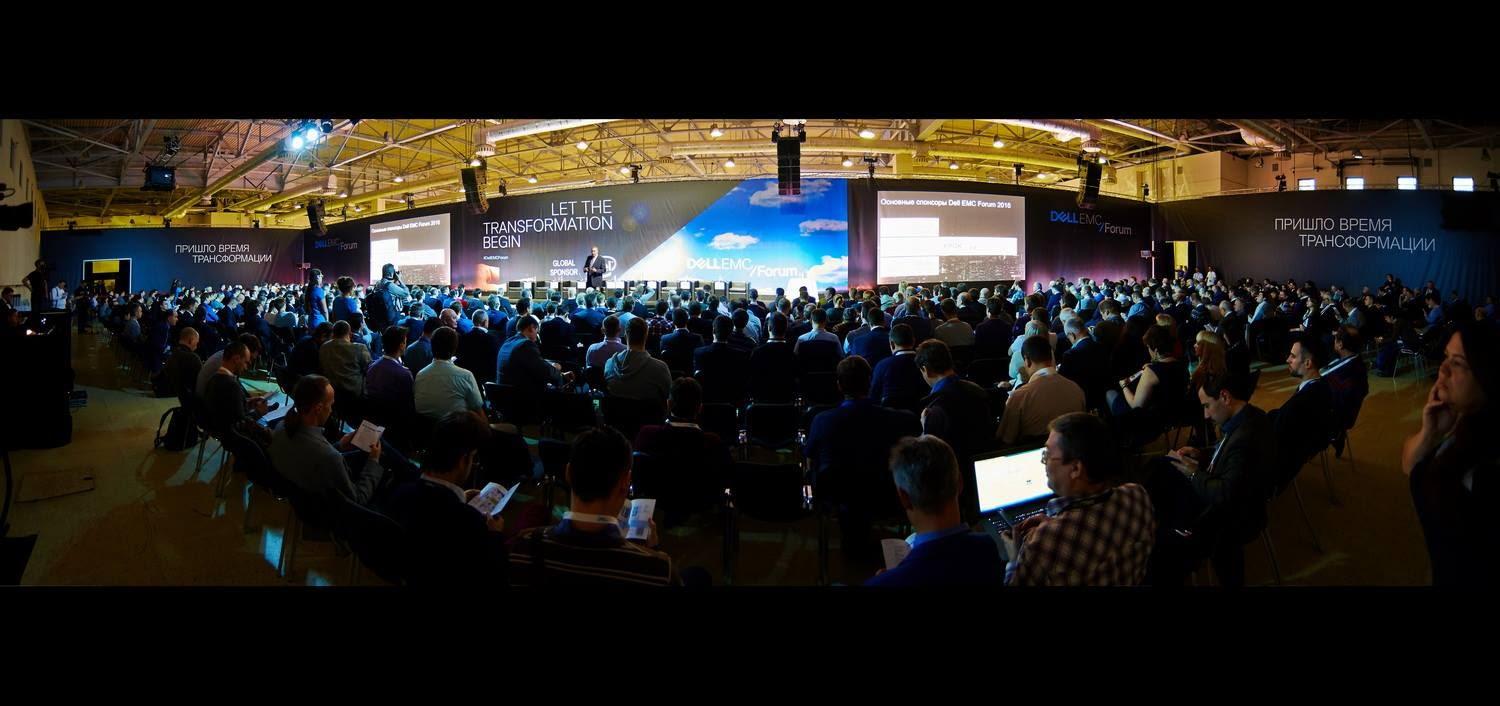
The realities of the modern market make us think about ways to modernize business and IT. Creating your own IT solution is fraught with a number of difficulties. Yes, and few people today come up with the idea, for example, to buy individual parts and assemble a car from them: too complicated and expensive. They buy a finished product that does not need to be integrated and tested independently. A converged system is such a turnkey solution.
Sales of convergent and hyperconverged systems in Russia are still small, but interest in them is very high, and many customers are now testing such solutions. Note that the main value of such systems is not hardware platforms, but software.
What are the advantages associated with the introduction of new technologies and the transformation of IT, converged systems have? First of all, like any integrated systems, they accelerate modernization, increase IT efficiency, and reduce risks. At least that's what they were designed for.

Changing the architecture of systems - from traditional servers and storage to software-defined solutions with a high-speed network.
Hyperconvergence means a change in system architecture: individual servers and storage systems in the storage area network (SAN) are being replaced by a single solution - a virtualization platform with a high-speed Ethernet network and software-defined storage system (SDS) with flash drives. Moreover, integration can be carried out at different levels.
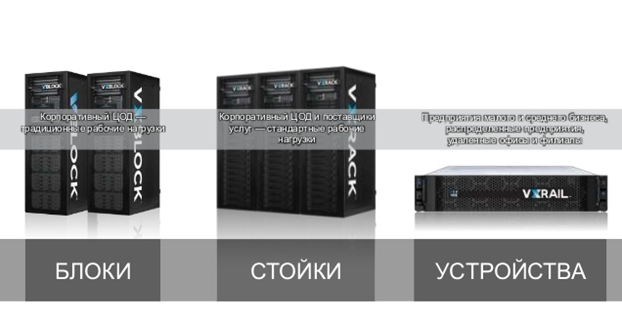
Dell EMC offers a comprehensive portfolio of converged and hyperconverged solutions spanning multiple levels: devices, racks, and units.
The choice of a solution of one level or another depends on the use case:
Dell EMC currently offers several hyperconverged models: standalone VxRail devices for VMware environments and XC series devices for other environments, VxRack 1000 rack systems with SDDC nodes, and VMware and VxRack 1000 environments with Flex nodes for scalable enterprise environments. As practice shows, hyper-converged infrastructure reduces TCO by 30% due to the lack of disparate storage facilities with excessive resource allocation, on-demand scaling and investment as it grows. VxRail is a turnkey solution on the basis of which you can deploy both a small data center and fairly large configurations. But for large-scale installations, there is another converged solution, rack-mount level - VxRack. Let us consider in more detail what it is.
Ready-made turnkey infrastructure VxRack is a switching cabinet with a set of hyperconverged nodes for specific tasks. If VxRail is positioned as a solution for small or remote data centers and mid-level tasks, then VxRack is an enterprise-class product for data centers, where one cluster contains hundreds of nodes. Such a system provides more opportunities in terms of scalability and efficiency.
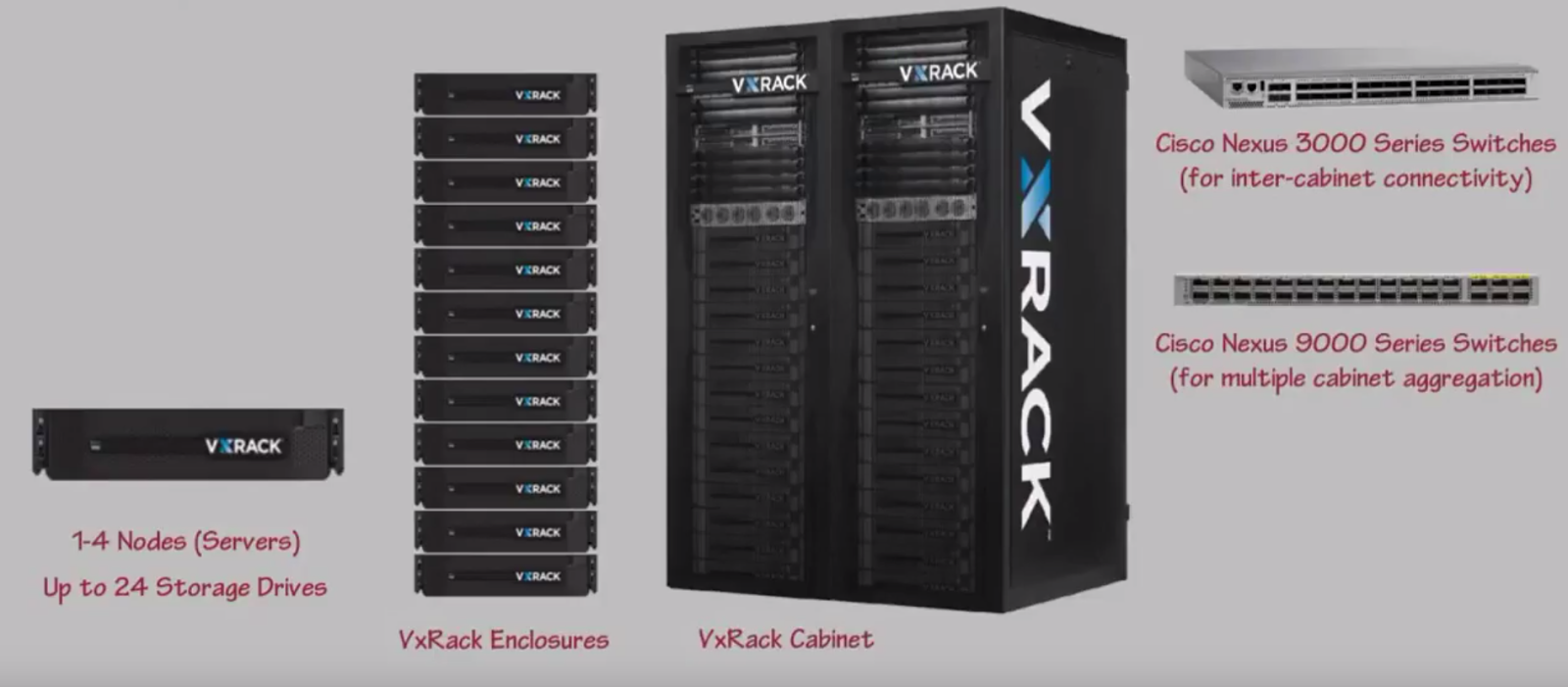
VxRack Rack contains from 6 to 48 server nodes (three are used for management), up to 24 drives in each. For networking between nodes and racks, Cisco Nexus 3000 and 9000 Series Rack Switches are used.
One of the key points is the finished network infrastructure. If building it for several tens of servers is quite simple, then when the IT infrastructure grows from 50 to 500 servers, this is already a difficult task. The off-the-shelf design of the VxRack network infrastructure ensures that network performance is not a problem when scaling.

The VxRack 1000 is a hyper converged system with an integrated rackmount factory optimized to increase responsiveness and lower transaction costs. This software-defined solution can support various types of workloads.
Features of the VxRack rack solution include high performance at any scale, simple horizontal scaling to multiple nodes, elimination of isolated storage points in the IT infrastructure.
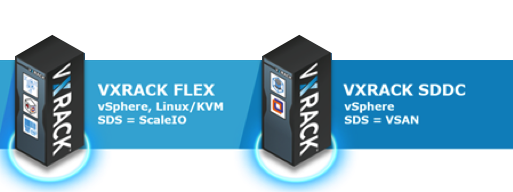
In fact, VxRack 1000 is a whole line of products. VxRack Rack Converged Systems are available in two versions.
Let us consider in more detail what they are.
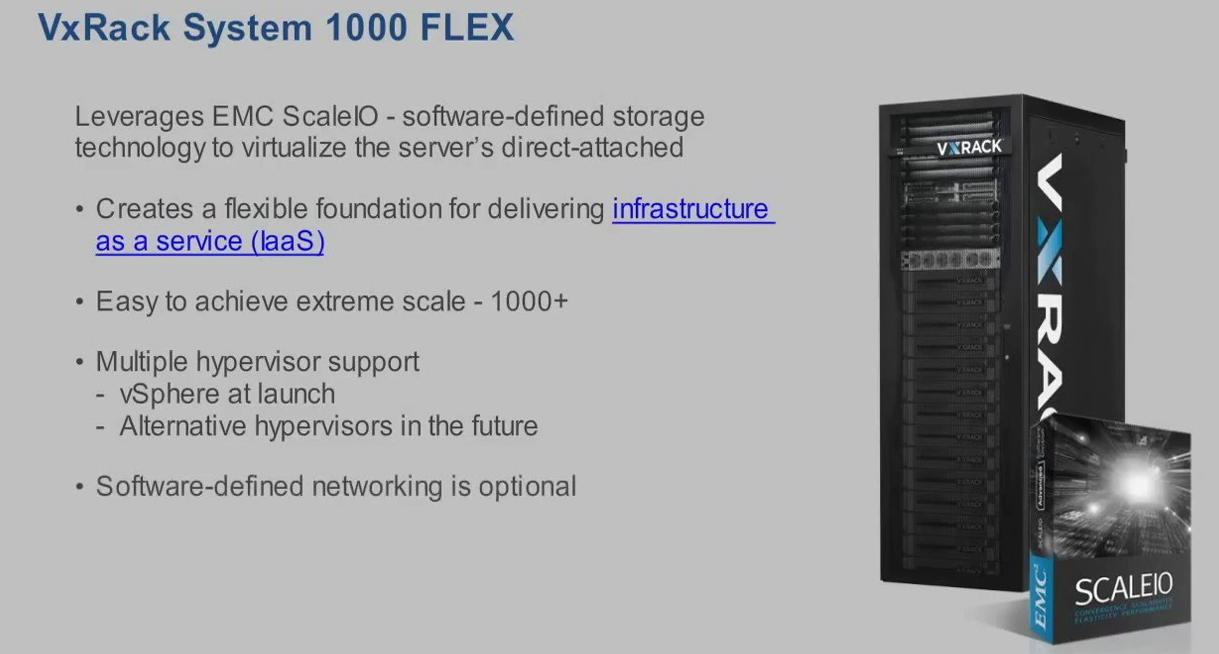
VxRack Flex uses Dell EMC ScaleIO software, which virtualizes storage connected directly to the server. This system can serve as the basis for IaaS services and is able to support enterprise and modern applications in a wide range of scenarios.
The VxRack Flex system scales to 1,000 nodes or more, allows you to use different hypervisors, create a heterogeneous infrastructure. VxRack Flex nodes are Dell EMC PowerEdge R630 or R730xd servers with flash or hybrid storage - up to 38.4 and up to 46 TB per node, respectively. The target applications of such systems are virtualized workloads, high-performance computing, file handling.
ScaleIO software combines the available storage capacity into a single array. A software agent runs on each node, thanks to which the node acts as a data source. The software agent also emulates the iSCSI driver. As a result, a virtual device is created in which the storage resources of all nodes are assembled into a single data storage array with block access.
VxRack FLEX nodes

VxRack SDDC is built on VMware Cloud Foundation software with automated deployment and management tools.
VxRack SDDC Nodes

Management in SDDC Manager.
Vblock Converged Infrastructure is an evolutionary approach to data center development. Vblock blocks also include network infrastructure. High-speed network allows you to move the load between nodes. With 64 nodes, the data network would become overly complex and inefficient, so Vblock already integrated the network infrastructure into the system. This greatly simplifies scaling.
Block converged systems also exist in three versions:
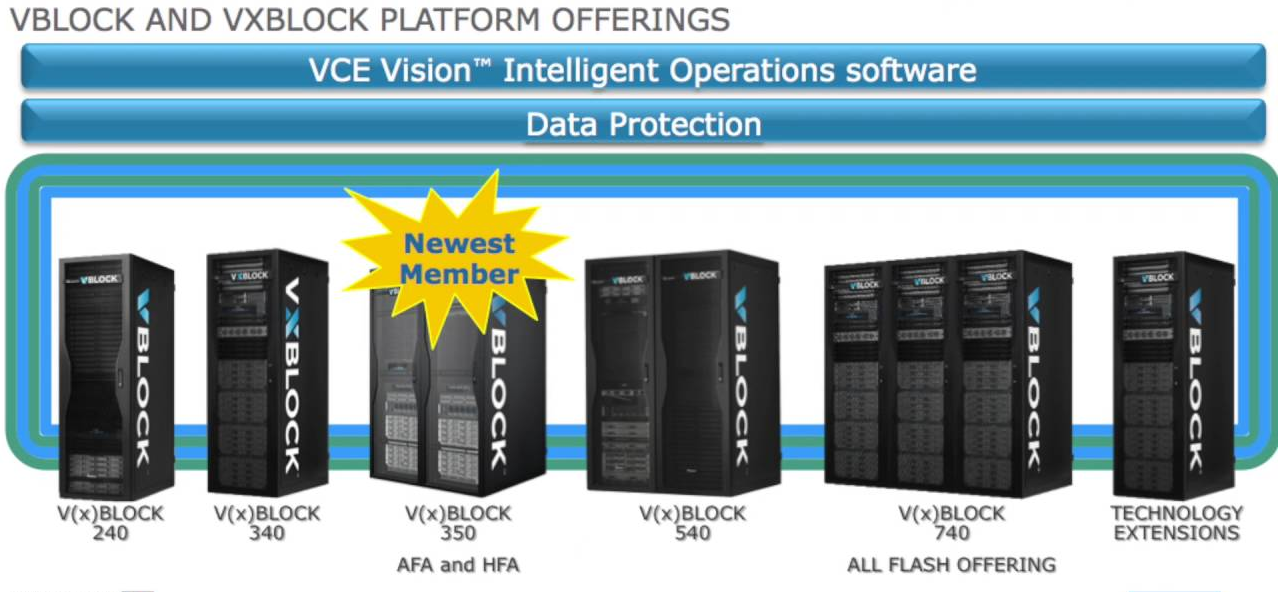
Vblock configurations.
Vblock is designed as a single product. Dell EMC has a long-term plan for its development, optimization and integration. The engineering team brings together architects, data center operations experts, software developers, and application specialists. Vblock is an established engineering cycle with support for quality standards, a well-thought-out system architecture and configuration, integration / compatibility matrixes and a single delivery model.
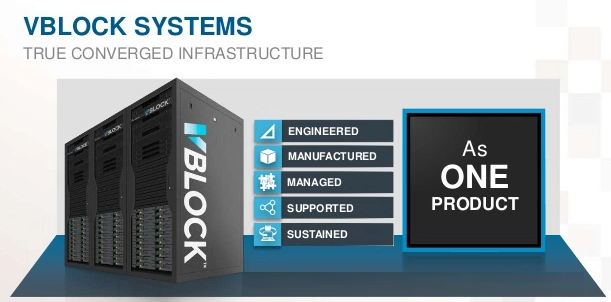
Managed and maintained by Vblock as a single product.
It takes only 48 hours to put the system into operation. The Vblock system has integrated data protection functions; it is offered guarantees for delivery and implementation. According to statistics, more than 90% of requests are resolved without escalation. Provides direct access to support engineers to vendor resources, regular software updates and recommendations.
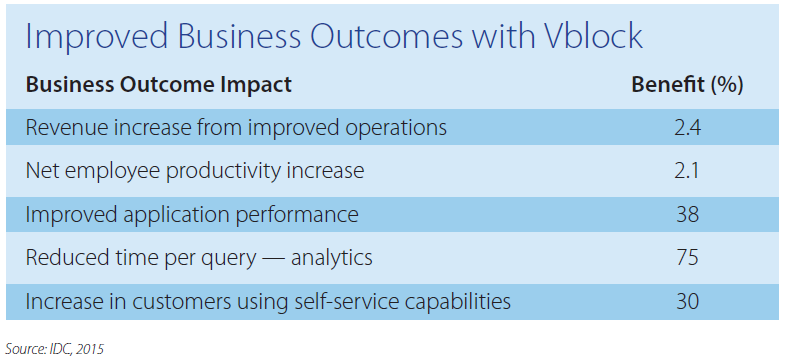
Vblock is a fully integrated converged data center infrastructure platform designed to simplify private cloud deployment. Pre-configured Vblock systems integrate network infrastructure for data transfer and storage, computing resources, virtualization technologies, data storage infrastructure, management tools, as well as additional equipment for organizing racks, cable connections and power supplies. You can use a software package called VCE Vision Intelligent Operations to manage various Vblock components.
Like VxRack, Vblock is a whole set of configurations, but this system, unlike VxRack with ScaleIO software, has no restrictions on combining nodes. In one system, you can combine both flash and hybrid nodes, you can create a tiered storage system with levels of different performance. Thus, Vblock allows you to build a more flexible configuration.

VCE Vision software can be integrated with VMware vCenter: VMware administrators will use the familiar vCenter interface as their primary management tool.
VxBlock and Vblock systems use technologies from Dell EMC, Cisco, VMware and other vendors. All their elements are preconfigured and tested: the system is a single, effectively managed solution. VxBlock and Vblock allow you to create modern data centers, entirely built on flash arrays. You can use the Dell EMC Unity, XtremIO, and VMAX storage options for this. The status of the systems is controlled by VCE Vision software. It manages the computing nodes, network, storage systems and virtualization components as a single pool of resources, automates security management. The VCE Vscale architecture simplifies the horizontal and vertical scaling of data centers. With the Dell EMC Fabric Network Factory with scalable spine-leaf architecture, you can connect a large number of systems and modular components to the network,
Several VxBlock and Vblock converged systems are available: the 200th series for SMBs and branch offices based on Dell EMC VNX5200 storage systems, the 300th series with Dell EMC Unity and Dell EMC VNX storage options - flexible and scalable solutions for virtualized data centers, the 500th the Dell EMC XtremIO flash array series that can be combined with the Dell EMC Isilon; and the 700th series with industry-leading performance, scalability, and availability with the Dell EMC VMAX hybrid or flash arrays.

Converged infrastructure based on VxRail and Vblock is a turnkey solution.
Converged solutions appeared in response to the market's need for the rapid deployment of computing infrastructure with the increasing complexity of integrating its components (servers, storage systems, network equipment). While the market for traditional infrastructure IT solutions in the world is practically not growing, the market for converged systems over the past five years has grown almost four times. Organizations choose convergent solutions when they want to abandon the problems of "self-assembly" when building a data center so that they do not have to buy, assemble and maintain individual components from various sources. In the case of a converged infrastructure, the supplier provides everything from installing and launching a solution to technical support of both hardware and software components that are part of it. In fact,

Convergence as a Trend
The realities of the modern market make us think about ways to modernize business and IT. Creating your own IT solution is fraught with a number of difficulties. Yes, and few people today come up with the idea, for example, to buy individual parts and assemble a car from them: too complicated and expensive. They buy a finished product that does not need to be integrated and tested independently. A converged system is such a turnkey solution.
Sales of convergent and hyperconverged systems in Russia are still small, but interest in them is very high, and many customers are now testing such solutions. Note that the main value of such systems is not hardware platforms, but software.
What are the advantages associated with the introduction of new technologies and the transformation of IT, converged systems have? First of all, like any integrated systems, they accelerate modernization, increase IT efficiency, and reduce risks. At least that's what they were designed for.

Changing the architecture of systems - from traditional servers and storage to software-defined solutions with a high-speed network.
Hyperconvergence means a change in system architecture: individual servers and storage systems in the storage area network (SAN) are being replaced by a single solution - a virtualization platform with a high-speed Ethernet network and software-defined storage system (SDS) with flash drives. Moreover, integration can be carried out at different levels.

Dell EMC offers a comprehensive portfolio of converged and hyperconverged solutions spanning multiple levels: devices, racks, and units.
The choice of a solution of one level or another depends on the use case:
| Type of Solution | Features |
| Hyper Converged Devices | Ease of use, cost-effective, minimal initial configuration with expandability |
| Hyper Converged Rack Systems | High scalability from small volumes, off-the-shelf network infrastructure, lowest TCO on a small scale |
| Converged Conventional Infrastructure | Scalability, reliable data management services, low TCO |
Dell EMC currently offers several hyperconverged models: standalone VxRail devices for VMware environments and XC series devices for other environments, VxRack 1000 rack systems with SDDC nodes, and VMware and VxRack 1000 environments with Flex nodes for scalable enterprise environments. As practice shows, hyper-converged infrastructure reduces TCO by 30% due to the lack of disparate storage facilities with excessive resource allocation, on-demand scaling and investment as it grows. VxRail is a turnkey solution on the basis of which you can deploy both a small data center and fairly large configurations. But for large-scale installations, there is another converged solution, rack-mount level - VxRack. Let us consider in more detail what it is.
VxRack - rack-level hyperconvergence
Ready-made turnkey infrastructure VxRack is a switching cabinet with a set of hyperconverged nodes for specific tasks. If VxRail is positioned as a solution for small or remote data centers and mid-level tasks, then VxRack is an enterprise-class product for data centers, where one cluster contains hundreds of nodes. Such a system provides more opportunities in terms of scalability and efficiency.

VxRack Rack contains from 6 to 48 server nodes (three are used for management), up to 24 drives in each. For networking between nodes and racks, Cisco Nexus 3000 and 9000 Series Rack Switches are used.
One of the key points is the finished network infrastructure. If building it for several tens of servers is quite simple, then when the IT infrastructure grows from 50 to 500 servers, this is already a difficult task. The off-the-shelf design of the VxRack network infrastructure ensures that network performance is not a problem when scaling.

The VxRack 1000 is a hyper converged system with an integrated rackmount factory optimized to increase responsiveness and lower transaction costs. This software-defined solution can support various types of workloads.
Features of the VxRack rack solution include high performance at any scale, simple horizontal scaling to multiple nodes, elimination of isolated storage points in the IT infrastructure.

In fact, VxRack 1000 is a whole line of products. VxRack Rack Converged Systems are available in two versions.
| System | Intended use |
| VxRack Flex | General Purpose Heterogeneous System |
| VxRack SDDC | VMware Scalable Environment |
Let us consider in more detail what they are.
VxRack Flex System

VxRack Flex uses Dell EMC ScaleIO software, which virtualizes storage connected directly to the server. This system can serve as the basis for IaaS services and is able to support enterprise and modern applications in a wide range of scenarios.
The VxRack Flex system scales to 1,000 nodes or more, allows you to use different hypervisors, create a heterogeneous infrastructure. VxRack Flex nodes are Dell EMC PowerEdge R630 or R730xd servers with flash or hybrid storage - up to 38.4 and up to 46 TB per node, respectively. The target applications of such systems are virtualized workloads, high-performance computing, file handling.
ScaleIO software combines the available storage capacity into a single array. A software agent runs on each node, thanks to which the node acts as a data source. The software agent also emulates the iSCSI driver. As a result, a virtual device is created in which the storage resources of all nodes are assembled into a single data storage array with block access.
VxRack FLEX nodes
- More than 20 types: 1U1N, 2U1N, 2U4N with different combinations of processors, memory and drives
- Virtualization: vSphere, Hyper-V, KVM (RHEL). You can use any other hypervisor and OS options in bare-metal mode ...
- SDS: ScaleIO
- SDN: none or NSX
- management and orchestration: VxRack Manager and VCE Vision.
- Scaling: up to 1000 nodes
- Purpose: VxRack System 1000 with VxRack FLEX nodes is a well-scalable system that supports SDS and various virtualization mechanisms.
VxRack SDDC and VxRack Neutrino Systems

VxRack SDDC is built on VMware Cloud Foundation software with automated deployment and management tools.
VxRack SDDC Nodes
- One Type: 1U1N
- Virtualization: vSphere Only
- SDS: VSAN
- SDN: NSX
- Management and orchestration: VMware SDDC Manager (lower level) and VCE Vision, as well as vRealize Operations and NSX. OpenStack integrated solutions and containers are supported with VMware.
- Scaling: up to 256 nodes
- Purpose: VxRack System 1000 with VxRack SDDC nodes can be used to deploy VMware environments and build software-defined data centers (SDDCs). This is a larger hardware and software complex than the VxRail Appliance.

Management in SDDC Manager.
Vblock - building blocks for data centers
Vblock Converged Infrastructure is an evolutionary approach to data center development. Vblock blocks also include network infrastructure. High-speed network allows you to move the load between nodes. With 64 nodes, the data network would become overly complex and inefficient, so Vblock already integrated the network infrastructure into the system. This greatly simplifies scaling.
Block converged systems also exist in three versions:
| System | Specifications |
| Vblock 300 based on Dell EMC Unity | Optimized capacity |
| Vblock 500 based on Dell EMC XtremIO | Horizontally scalable storage with flash data deduplication |
| Vblock 700 based on Dell EMC VMAX | Efficiency, automation, fault tolerance for demanding and critical applications |

Vblock configurations.
Vblock is designed as a single product. Dell EMC has a long-term plan for its development, optimization and integration. The engineering team brings together architects, data center operations experts, software developers, and application specialists. Vblock is an established engineering cycle with support for quality standards, a well-thought-out system architecture and configuration, integration / compatibility matrixes and a single delivery model.

Managed and maintained by Vblock as a single product.
It takes only 48 hours to put the system into operation. The Vblock system has integrated data protection functions; it is offered guarantees for delivery and implementation. According to statistics, more than 90% of requests are resolved without escalation. Provides direct access to support engineers to vendor resources, regular software updates and recommendations.

Vblock Features
Vblock is a fully integrated converged data center infrastructure platform designed to simplify private cloud deployment. Pre-configured Vblock systems integrate network infrastructure for data transfer and storage, computing resources, virtualization technologies, data storage infrastructure, management tools, as well as additional equipment for organizing racks, cable connections and power supplies. You can use a software package called VCE Vision Intelligent Operations to manage various Vblock components.
Like VxRack, Vblock is a whole set of configurations, but this system, unlike VxRack with ScaleIO software, has no restrictions on combining nodes. In one system, you can combine both flash and hybrid nodes, you can create a tiered storage system with levels of different performance. Thus, Vblock allows you to build a more flexible configuration.

VCE Vision software can be integrated with VMware vCenter: VMware administrators will use the familiar vCenter interface as their primary management tool.
VxBlock and Vblock systems use technologies from Dell EMC, Cisco, VMware and other vendors. All their elements are preconfigured and tested: the system is a single, effectively managed solution. VxBlock and Vblock allow you to create modern data centers, entirely built on flash arrays. You can use the Dell EMC Unity, XtremIO, and VMAX storage options for this. The status of the systems is controlled by VCE Vision software. It manages the computing nodes, network, storage systems and virtualization components as a single pool of resources, automates security management. The VCE Vscale architecture simplifies the horizontal and vertical scaling of data centers. With the Dell EMC Fabric Network Factory with scalable spine-leaf architecture, you can connect a large number of systems and modular components to the network,
Several VxBlock and Vblock converged systems are available: the 200th series for SMBs and branch offices based on Dell EMC VNX5200 storage systems, the 300th series with Dell EMC Unity and Dell EMC VNX storage options - flexible and scalable solutions for virtualized data centers, the 500th the Dell EMC XtremIO flash array series that can be combined with the Dell EMC Isilon; and the 700th series with industry-leading performance, scalability, and availability with the Dell EMC VMAX hybrid or flash arrays.

Converged infrastructure based on VxRail and Vblock is a turnkey solution.
Converged solutions appeared in response to the market's need for the rapid deployment of computing infrastructure with the increasing complexity of integrating its components (servers, storage systems, network equipment). While the market for traditional infrastructure IT solutions in the world is practically not growing, the market for converged systems over the past five years has grown almost four times. Organizations choose convergent solutions when they want to abandon the problems of "self-assembly" when building a data center so that they do not have to buy, assemble and maintain individual components from various sources. In the case of a converged infrastructure, the supplier provides everything from installing and launching a solution to technical support of both hardware and software components that are part of it. In fact,
